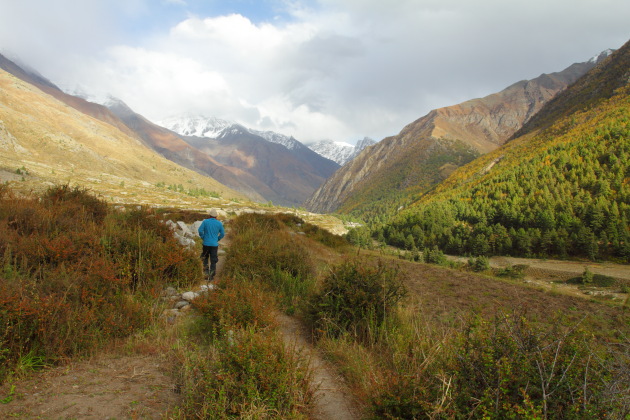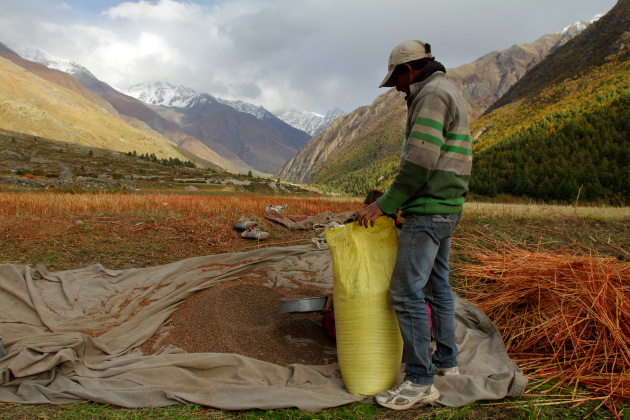
Starting at Chitkul, considered the last village on the Indo-Tibet border, this trek goes all the way to Sangla, one of the famous apple orchards of Himachal Pradesh. One can trek beyond Sangla upto Karcham, but there is too much dam construction downstream and hence the beauty of the river trek is lost beyond Sangla. This river trek from Chitkul to Sangla is about 16 kms long, whereas the distance by road is about 22 kms.

If you wish, you can trek by road too, but you will have to bear with the dusty conditions as army trucks and other vehicles keep plying regularly. The walk by road is much easier though. If you trek by the river, you will have to ascend and descend many times as the river meanders through gorges and wide open spaces. Even if you do get tired, which you will at many junctures, you can find a rock by the river and enjoy the spectacular views.

Once you start at Chitkul village, take the bridge below the village and cross on to the other bank of the river. From here, take a goat trail (I call it so as it has goat droppings all the way) and make your way through a dense pine forest. Once you cross this forest, you will start walking by the river, but at a slight altitude. Then, comes the most entertaining part of this river trek, the makeshift wooden log bridges.

Now, imagine this, you are surrounded by the mighty Himalayas on all sides and just below you (by about 50 feet) is the Baspa river. As you are standing in a valley, it is safe to assume that there would be many small streams and tributaries that will join the main Baspa river. You are walking on the left bank of the river and headed West-North West and you have to cross these many mountain streams. You cannot get yourself wet as the waters are extremely cold and sometimes turbulent. The only option left for you is jumping over rocks or crossing narrow wooden log bridges. Set at a decent height above the river, these bridges test your sense of balance and more so if you are carrying your backpack.

Once you cross the first main log bridge, you come to a rocky zone and then a small village and then begins a steep hike through the forests again. Then, you cross 2 more log bridges and then you drop down to the river and cross the narrow gorge. Then, in a short while, you will reach an iron bridge on the river. Cross onto the right bank and continue towards Rakcham. You can either camp overnight at Rakcham and enjoy the rural atmosphere here or continue downstream to Batseri. This stretch between Rakcham and Batseri has more villages and hence more agricultural land. If you are in season, you will see this entire land covered in shining red buck wheat.

At Batseri, camp overnight and explore the famous Devta temple here. The next morning, you can continue the trek to Sangla through apple orchards. As you approach Sangla, the river widens, there are larger meadows, more apple orchards, more farming and more cattle. Hence, this part of the trek will mean more interactions with the locals and more getting to see the local cultures. While, the previous stretch between Rakcham and Chitkul being more raw nature and forests.

This trek is fairly easy, but it is not accessible all through the year. In fact, it is only accessible during the time from September through February when there is no rain and the river and its tributaries shrink. Unlike other Himalayan treks, this river trek will become impossible when the snow melts and all small tributaries become swollen with water. In order to prepare for this trek, carry a headlamp or flashlight, some high energy bars, 2 liters of water per person unless you are fine to drink the river water, a pair of sunglasses and a good pair of boots (don’t bother with running or tennis shoes as the combinations of rock and water will wear them out pretty quickly). A warm layer will help as the early mornings and late evenings get nippy. There is no phone coverage for most of the duration of this trek and hence download your maps so that you can access it in offline mode.

If you are carrying your tent, don’t keep your surroundings clean without any food scraps as this is bear country. If you intend to stay in a hotel room, Batseri, Rakcham and Sangla have lots of hotels, camps and guest houses to choose from.
No comments:
Post a Comment